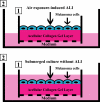The air liquid-interface, a skin microenvironment, promotes growth of melanoma cells, but not their apoptosis and invasion, through activation of mitogen-activated protein kinase
- PMID: 20300218
- PMCID: PMC2840220
- DOI: 10.1267/ahc.09036
The air liquid-interface, a skin microenvironment, promotes growth of melanoma cells, but not their apoptosis and invasion, through activation of mitogen-activated protein kinase
Abstract
The air-liquid interface (ALI) is a common microenvironment of the skin, but it is unknown whether the ALI affects melanoma cell behaviors. Using a collagen gel invasion assay, immunohistochemistry, and Western blots, here we show that melanoma cell proliferation in cultures with an ALI is higher than melanoma cell proliferation in submerged cultures. Bromodeoxyuridine (BrdU) uptake, an indicator of cell proliferation, of melanoma cells at the ALI was about 3 times that of submerged cells, while ALI and submerged melanoma cells had similar levels of single-stranded DNA (a marker of apoptosis). The ALI enhanced the expression of Raf-1, MEK-1 and pERK-1/2 components of the mitogen-activated protein kinase (MAPK) cascade, in cells more than the submerged condition did. The increases in BrdU uptake and pERK-1/2 expression promoted by ALI was abolished by the MEK inhibitor, PD-98059. ALI-treated and submerged melanoma cells did not infiltrate into the collagen gel, and they showed no significant difference in the expression of the invasion- and motility-related molecules, matrix metalloproteinase-1 and -9, laminin 5, and filamin A. Our data indicate that the ALI, a skin microenvironment, accelerates the growth, but not the apoptosis or invasion, of melanoma cells through MAPK activation.
Keywords: air-liquid interface; collagen gel invasion assay; melanoma; mitogen-activated protein kinase; proliferation.
Figures






References
-
- Barnhill R. L., Gupta K. Unusual variants of malignant melanoma. Clin. Dermatol. 2009;27:564–587. - PubMed
-
- Bebok Z., Tousson A., Schwiebert L. M., Venglarik C. J. Improved oxygenation promotes CFTR maturation and trafficking in MDCK monolayers. Am. J. Physiol. Cell Physiol. 2001;280:C135–C145. - PubMed
-
- Bennett D. C. Genetics, development, and malignancy of melanocytes. Int. Rev. Cytol. 1993;146:191–260. - PubMed
-
- Bouffard D., Duncan L. M., Howard C. A., Mihm M. C., Jr., Byers H. R. Actin-binding protein expression in benign and malignant melanocytic proliferations. Hum. Pathol. 1994;25:709–714. - PubMed
-
- Brown D. Structure and function of membrane rafts. Int. J. Med. Microbiol. 2002;291:433–437. - PubMed
LinkOut - more resources
Full Text Sources
Research Materials
Miscellaneous

